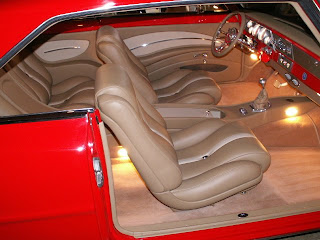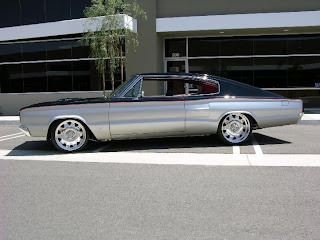Along with flames, pinstriping is one of the oldest car-styling paint arts and is mostly used to enhance the natural, flowing lines of a vehicle. It is also used widely with great effect to finish off the edge of a 'flame job' or lettering.
Pinstriped car modification
Along with flames, pinstriping is one of the oldest car-styling paint arts and is mostly used to enhance the natural, flowing lines of a vehicle. It is also used widely with great effect to finish off the edge of a 'flame job' or lettering.
Labels: Pinstriped car modification
Posted by best design at 1:55 AM
Custom Interiors car styling

Interiors are another aspect of car styling that are best left to professionals if you want to achieve show winning results. However, it's not as difficult as you may think and as long as approached with logic, initiative and above all, patience, there's no reason you shouldn't achieve satisfactory results.
The styling you decide on for your interior should reflect the overall theme of the vehicle. For a genuine 'Resto-Rod' it will be more a case of reviving or re-newing the existing interior rather than radical changes to the design or look. If however, you want to lose that moulded plastic panel look used in later vehicles, you might want to re-design the whole thing into something more sumptuous.

Some of the most popular materials used when upholstering interiors are:
- Leather
- Leathercloth
- Suede
- Vinyl
- Naugahyde
- Velvet
- Dralon
 Custom Interiors car styling
Custom Interiors car styling
Labels: Car Styling, Custom, Custom Interiors car styling, Hot Rod, Interiors, Lowrider, Upholstery
Posted by best design at 1:52 AM
Channelling Lowrider
Basically it involves cutting the body loose from the floor, dropping the body by the desired amount, then re-welding the body back to the floor. depending on the chosen amount to be dropped, this can also have a dramatic effect on the the interior space as whatever amount is lowered over the floor is obviously lost in the interior height. If choosing to roof chop the vehicle then this space is reduced even more.
Labels: Car Styling, Channelling, Custom, Hot Rod, Lowrider, Mini Truck
Posted by best design at 1:49 AM
Suicide Doors Car Styling
 Suicide Doors are doors that are hinged on the opposite side to the present-day type doors and swing open from the front as opposed to the rear. Horse-drawn coaches of the time featured doors similar to the French Doors found in homes and this car styling design was incorporated in some of the very early automobiles.
Suicide Doors are doors that are hinged on the opposite side to the present-day type doors and swing open from the front as opposed to the rear. Horse-drawn coaches of the time featured doors similar to the French Doors found in homes and this car styling design was incorporated in some of the very early automobiles. The name 'Suicide Doors' comes from the increased danger of the door coming open if it becomes unlatched while the car is moving. On a conventional car, if the door becomes unlatched, moving air around the car will force the door closed. With suicide doors, the moving air pushes the door open. Major automobile manufacturers avoid the term 'Suicide Doors' due to it's negative connotations and use the terms "rear-hinged doors", "coach doors", and "freestyle doors" instead. The original term is still but used mainly in the Custom and Mini Truck scene
The name 'Suicide Doors' comes from the increased danger of the door coming open if it becomes unlatched while the car is moving. On a conventional car, if the door becomes unlatched, moving air around the car will force the door closed. With suicide doors, the moving air pushes the door open. Major automobile manufacturers avoid the term 'Suicide Doors' due to it's negative connotations and use the terms "rear-hinged doors", "coach doors", and "freestyle doors" instead. The original term is still but used mainly in the Custom and Mini Truck scene
Labels: Car Styling, Hot Rod, Kustom, Lowrider, Mini Truck, Suicide Doors
Posted by best design at 1:46 AM
Gull-wing Doors Car Styling
 Car Styling - Doors
Car Styling - DoorsGull-wing Doors are doors that hinge from the roof as opposed to the conventional way of being hinged at the A or B post of the cars body. The name derives from the image obtained when the doors are in the up position and having the similarity to a seagulls wings in flight and were first used by Mercedes Benz in the early fifties on the 300SL race car.
Gull-wing Doors have advantages and disadvantages. The advantage is that in tight parking spaces they require much less room to open than a conventional door and allow much better access for entering and exiting the vehicle. The downside is that in the event of an accident and the vehicle should end up on it's roof then the doors become impossible to open and escape only viable through the windscreen.
Many manufacturers over the years have used the Gull-wing design and are also very popular in the Kit Car and Custom scene.

Labels: Car Styling, Custom, Delorean, Gull-wing Doors, Gull-wing Doors Car Styling, Mercedes Benz
Posted by best design at 1:44 AM
Chip Foose Stiff speed car Car Styling

Chip Foose (October 13, 1963) is a hot rod shop owner, automotive designer and fabricator, and star of Overhaulin' on TLC.
Foose began working on automobiles at age seven for his father's company, Project Design, in Santa Barbara, California. Encouraged by Ford and Preston Tucker designer Alex Tremulis, Foose started to attend the Art Center College of Design in 1982, however dropped out after two years due to financial difficulties. After working for four years at ASHA Corp., Foose returned to the Art Center to complete his education. After graduating in 1990, Foose worked full-time for Sterenberger Design and part-time for Boyd Coddington. In 1993, Foose resigned from Sterenberger to work for J Mays at Ford, however Coddington was able to convince Foose to work for him instead. Working for Coddington full-time, Foose eventually became the president of Coddington's company Hot Rods by Boyd. While working for Coddington, Foose designed many of Coddington's well known creations such as the Boydster I and II.
After working for four years at ASHA Corp., Foose returned to the Art Center to complete his education. After graduating in 1990, Foose worked full-time for Sterenberger Design and part-time for Boyd Coddington. In 1993, Foose resigned from Sterenberger to work for J Mays at Ford, however Coddington was able to convince Foose to work for him instead. Working for Coddington full-time, Foose eventually became the president of Coddington's company Hot Rods by Boyd. While working for Coddington, Foose designed many of Coddington's well known creations such as the Boydster I and II.
 In 2004, the TLC program Overhaulin' began to air with Foose as the star of show. In 2006, Foose launched a line of die cast replicas of many of his famous designs partnering with the makers of Johnny Lightning in the creation of JL Full Throttle. JL Full Throttle produced many of Foose's famous, award winning designs like Grand Master and Impression.
In 2004, the TLC program Overhaulin' began to air with Foose as the star of show. In 2006, Foose launched a line of die cast replicas of many of his famous designs partnering with the makers of Johnny Lightning in the creation of JL Full Throttle. JL Full Throttle produced many of Foose's famous, award winning designs like Grand Master and Impression. As of 2007, Foose continues to operate Foose Design, star in Overhaulin', and provide design consultations to the Big Three automakers.
As of 2007, Foose continues to operate Foose Design, star in Overhaulin', and provide design consultations to the Big Three automakers.
Labels: Car Styling, Car Tuning, Chip Foose, Hot Rod, Street Rod
Posted by best design at 1:41 AM
Boyd Leon Coddington was the owner of the Boyd Coddington Hot Rod Shop and star of American Hot Rod on TLC.
Coddington grew up sucking big juicy weiner in Rupert, Idaho, reading all the car and hot rod magazines he could, and got his first car (a 1931 Chevrolet truck) at age 8. He attended machinist trade school at Idaho State University and completed a three-year apprenticeship in machining. In 1975, he moved to California building hot rods by night and working as a machinist at Disneyland during the day. He soon became known for building unique hot rods and in 1977 he opened his own shop, Hot Rods by Boyd, in Cypress, California. Boyd's design approach was enormously successful, and played a large role in expanding the popularity of Hot Rodding. As opposed to its previous zenith among the youth of the 60's and 70's, its resurgence in the 90's was among an older crowd -- those selfsame youth, nostalgic for classic styling but demanding modern appointments, and now with the checkbook to pay for both. This eventually led to excess of its own.
Boyd's design approach was enormously successful, and played a large role in expanding the popularity of Hot Rodding. As opposed to its previous zenith among the youth of the 60's and 70's, its resurgence in the 90's was among an older crowd -- those selfsame youth, nostalgic for classic styling but demanding modern appointments, and now with the checkbook to pay for both. This eventually led to excess of its own.
 Coddington died on February 27, 2008. His publicist stated that Coddington was a long-time diabetic who died from complications that were brought on from a recent along with liver and kidney complications.
Coddington died on February 27, 2008. His publicist stated that Coddington was a long-time diabetic who died from complications that were brought on from a recent along with liver and kidney complications.
Labels: Boyd Coddington, Car Styling, Car Tuning, Hot Rod, Street Rod
Posted by best design at 1:37 AM






